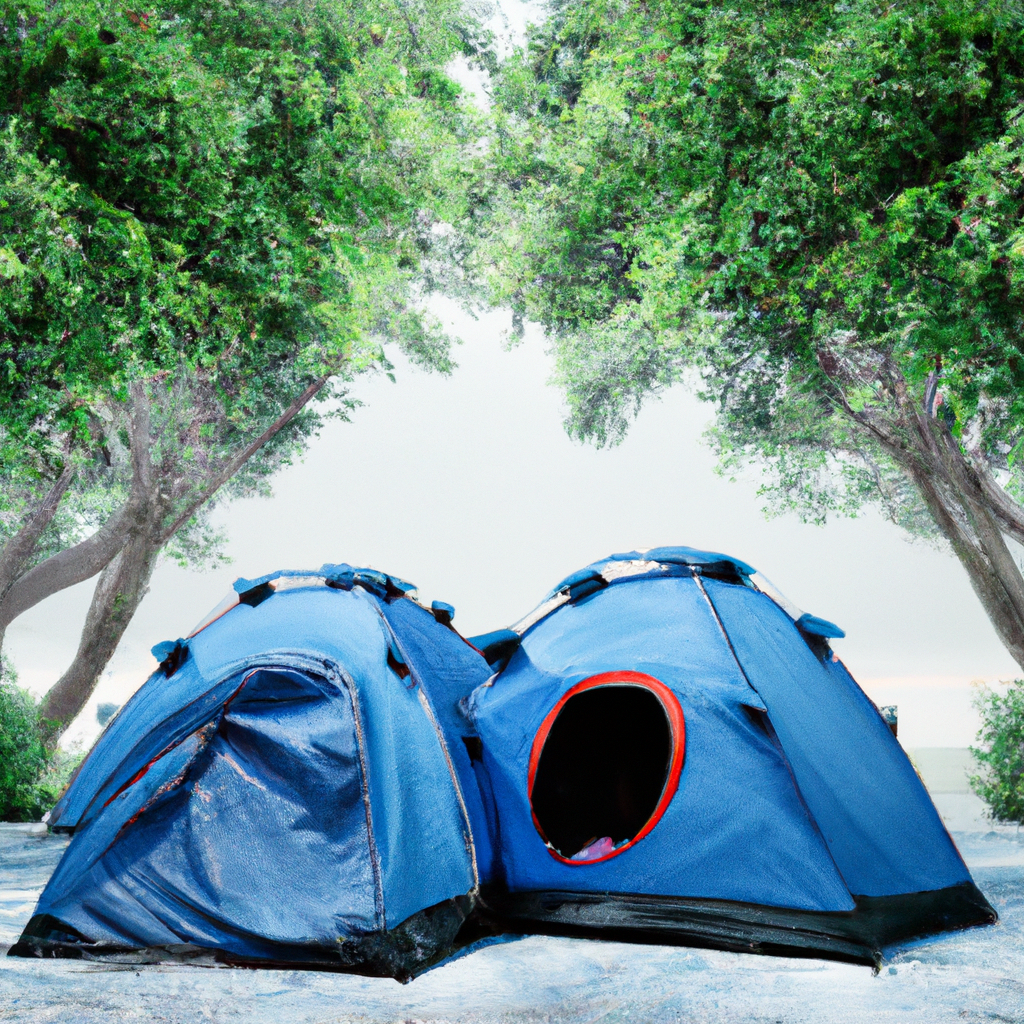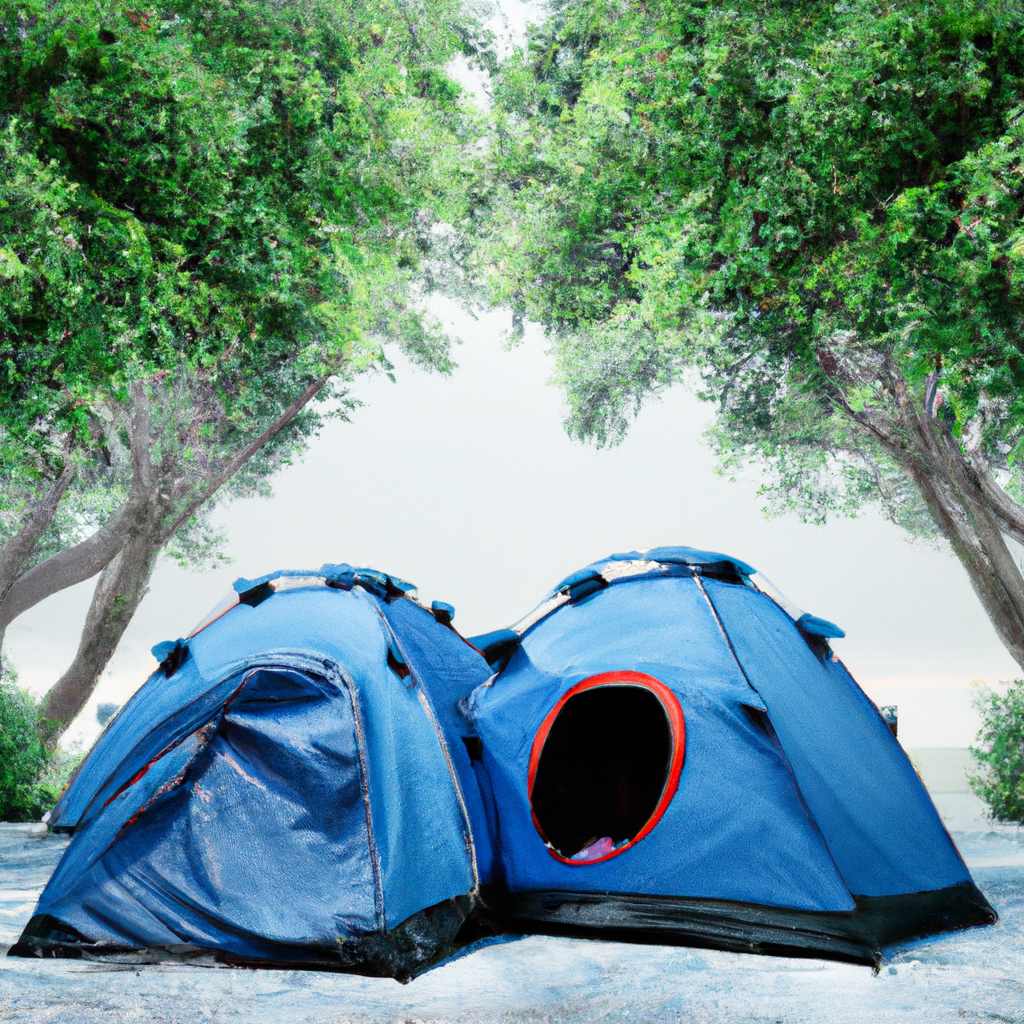Imagine embarking on a camping trip, eager to connect with nature and bask in the serenity of the great outdoors. As you prepare to pitch your tent, an important question looms in your mind: how do you choose a safe and secure tent site to avoid the nightmare of unexpected flooding? In this article, we will guide you through the essential factors to consider, ensuring that your next camping experience remains dry, enjoyable, and truly memorable. So, grab your compass and let’s chart a course towards a flood-free adventure!

Understanding the Risk of Flooding
Flooding can pose a significant risk to campers, as it can not only destroy personal belongings but also put lives in danger. Therefore, it is crucial to understand the different types of flooding and the areas that are prone to these occurrences. By having this knowledge, you can make informed decisions and choose a safe tent site that minimizes the risk of flooding.
Types of Flooding
When selecting a tent site, it is essential to be aware of the different types of flooding that can occur. These include river flooding, flash flooding, and urban flooding. River flooding happens when heavy rainfall causes rivers or streams to overflow their banks. Flash flooding, on the other hand, occurs suddenly and is characterized by a rapid rise in water levels. Urban flooding is a result of excess runoff from impermeable surfaces in cities. Understanding these types of flooding will help you assess the potential risks associated with each type and choose a site accordingly.
Areas Prone to Flooding
Certain regions are more prone to flooding than others. Low-lying areas, floodplains, and locations near rivers, lakes, or streams are particularly susceptible to flooding. It is important to research the area you plan to camp in and identify if it falls within a flood-prone zone. Additionally, considering the local climate and weather patterns can provide valuable insights into whether an area experiences high rainfall that could lead to flooding. By avoiding flood-prone areas, you significantly reduce the chances of encountering a flood during your camping trip.
Importance of Choosing a Safe Tent Site
Choosing a safe tent site that minimizes the risk of flooding is crucial for the safety and enjoyment of your camping experience. Flooding can not only damage your equipment and supplies but can also pose serious health and safety risks. By selecting a site away from flood-prone areas and taking necessary precautions, you can ensure that your camping trip remains safe and dry.
Researching Potential Campsites
Before embarking on your camping adventure, it is necessary to research potential campsites to find a safe and secure location that will minimize the risk of flooding. By gathering information on local weather and rainfall data, topographical maps, and utilizing online resources and apps, you can make an informed decision about the best campsite for your needs.
Local Weather and Rainfall Data
One of the key factors in determining the risk of flooding is understanding the local weather patterns and historical rainfall data. This information can be obtained through local meteorological agencies or online weather databases. By analyzing the rainfall patterns in the area you plan to camp in, you can identify periods of heavy rain and assess the likelihood of flooding. This knowledge will assist you in selecting a campsite that has a lower risk of flooding.
Topographical Maps and Elevation
Topographical maps provide valuable information about the terrain and elevation of an area. By studying these maps, you can identify potential low-lying areas or floodplains that are prone to flooding. It is advisable to choose a campsite that is situated at a higher altitude, as this reduces the risk of flooding. Mapping out potential sites and comparing their elevations will help you find a safe location for your tent.
Online Resources and Apps
In today’s digital age, there are numerous online resources and smartphone apps that can assist you in choosing a safe tent site. These resources provide valuable information, including flood zone maps, weather forecasts, and real-time updates on flood warnings. Utilizing these tools can help you make informed decisions and ensure that you select a campsite that is not at risk of flooding.
On-Site Evaluation
Once you have researched potential campsites, it is essential to perform an on-site evaluation before setting up your tent. This evaluation involves inspecting the area for previous flood damage, identifying natural drainage patterns, and assessing soil type and composition.
Inspecting the Area for Previous Flood Damage
Before setting up your tent, it is crucial to look for signs of previous flood damage in the area. This can include debris, erosion marks, or water stains on trees or nearby structures. By identifying these signs, you can determine whether the site has a history of flooding and adjust your tent placement accordingly. It is advisable to avoid areas that have evident flood damage.
Identifying Natural Drainage Patterns
Understanding the natural drainage patterns in an area is crucial for selecting a safe tent site. By observing the land’s slope and identifying where the water flows, you can avoid areas that are likely to accumulate water during heavy rainfall. Choosing a site that is on higher ground and positioned away from natural drainage paths will reduce the risk of flooding.
Assessing Soil Type and Composition
The type and composition of the soil can significantly impact its ability to drain water. Ideally, you should choose a campsite with well-draining soil, such as sandy or loamy soil, which allows water to penetrate and flow away easily. Avoid areas with clay or compacted soil, as they tend to retain water and increase the risk of flooding. By assessing the soil type and composition, you can select a tent site that provides better drainage and minimizes the risk of flooding.

Considerations for Tent Placement
When setting up your tent, there are several considerations to keep in mind that will further reduce the risk of flooding. By avoiding low-lying areas, choosing higher ground, and positioning your tent at a safe distance from water sources, you can enhance your camping experience and minimize the chances of encountering a flood.
Avoiding Low-Lying Areas
Low-lying areas are more prone to flooding as they are more likely to accumulate water during heavy rainfall. When choosing a tent site, it is crucial to steer clear of these areas. Look for higher ground that slopes away from potential flood zones, as this will provide a safer location for your tent.
Choosing Higher Ground
Selecting an elevated location for your tent is one of the most effective ways to minimize the risk of flooding. By positioning your tent on higher ground, water will naturally flow away from your camping area. This simple yet important consideration can make a significant difference in keeping your tent dry during heavy rain or flooding events.
Elevating your camping experience—literally—by choosing higher ground offers more than just breath-taking views. Camping on a hill enhances safety by keeping you above potential flood zones and away from overly damp or muddy conditions that can breed pests and make fires difficult to maintain. Plus, the natural elevation often provides a cooler breeze, offering relief during hotter days and improving air circulation at night.
Furthermore, pitching your tent on higher terrain adds an element of adventure, pushing you to explore trails less travelled. This elevated setting allows for stunning sunrises and sunsets that paint the sky with unforgettable colors while giving you an unobstructed view of the stars. The practicality combined with awe-inspiring moments makes camping on a hill not just smart but truly memorable.
Distance from Water Sources
While camping near a water source may seem picturesque, it can increase the risk of flooding. It is advisable to set up your tent at a safe distance from rivers, streams, or lakes. During heavy rainfall, these water bodies can quickly rise and flood nearby areas. By maintaining a safe distance, you ensure that your tent remains out of harm’s way.
Building Raised Platforms or Terracing
In areas where the risk of flooding cannot be completely eliminated, building raised platforms or terracing can provide additional protection for your tent. These techniques lift your tent off the ground, reducing the chances of water entering your camping area.
Transforming a sloped campsite into an inviting and practical living space with raised platforms or terracing can elevate your camping experience, both literally and figuratively. Begin by scouting local materials such as logs, flat rocks, and sturdy branches—which can serve as the foundation for your terraces. Prioritize sites with natural contours that are conducive to tiered construction. Once you’ve chosen your spot, dig shallow trenches horizontally across the slope; these will act as anchors for placing logs or rocks to create level surfaces.
Not only do these elevated platforms provide flat areas for sleeping and cooking, they also enhance drainage during rainstorms by promoting water runoff away from critical zones like tents and fire pits. Additionally, strategically placed terracing can help minimize soil erosion in sensitive environments—a key consideration for eco-conscious campers. Incorporate layers of foliage or small shrubs in each terrace to further stabilize the slope while enhancing the aesthetic appeal of your temporary homestead. Embrace this opportunity not just to sleep more comfortably but also to harmonize thoughtfully with nature’s landscape through innovative camp design.
Benefits of Raised Platforms
Building a raised platform for your tent has several benefits. It elevates your sleeping area, preventing water from seeping into your tent during heavy rain or flooding. Additionally, it provides a level and comfortable surface to set up your camping gear. By creating this barrier between you and the ground, you enhance your comfort and minimize the risk of flooding.
Materials and Construction
To build a raised platform, you will need sturdy materials such as wooden planks or pallets. Select materials that are resistant to water damage and can withstand the weight of your camping gear and tent. Secure the materials together using nails or screws, ensuring a stable and level platform. This simple construction project can provide significant protection against flooding.
Terracing Techniques for Sloped Areas
In areas with slopes or uneven terrain, terracing can be an effective technique for creating a level camping surface while also providing flood protection. Terracing involves creating multiple raised platforms or levels on a slope, with each level acting as a barrier against water runoff. By creating these distinct levels, you can prevent water from flowing down the slope and reaching your tent.
Preparing for Rain and Water Runoff
While choosing a safe tent site and implementing preventive measures significantly reduce the risk of flooding, it is essential to take additional steps to prepare for rain and water runoff during your camping trip. By using waterproof ground sheets, digging trenches or ditches, and creating diversion channels, you can further protect your tent from the potential effects of rainfall and flooding.
Using Waterproof Ground Sheets
A waterproof groundsheet is an essential item to invest in when camping in areas prone to rain or flooding. Placing a high-quality groundsheet beneath your tent provides an additional layer of protection against moisture. It acts as a barrier, preventing water from seeping through the tent floor and into your sleeping area. Be sure to properly secure and position the groundsheet to maximize its effectiveness.
Digging Trenches or Ditches
Digging trenches or ditches around your tent can help to redirect water away from your camping area. As water naturally flows downhill, creating ditches or trenches on higher ground can guide the water around your tent. Be mindful of the terrain and ensure that the trenches are angled for proper water flow. Regularly monitor the trenches during rainfall to ensure they are functioning effectively.
Creating Diversion Channels
In situations where runoff water is expected to flow directly towards your tent, creating diversion channels is a useful technique. By excavating a shallow channel on higher ground, you can redirect water away from your camping area. Ensure that the channel slopes away from your tent and directs water towards safe drainage areas. This proactive measure can help prevent flooding in your campsite.
Knowledge of Water Flow
Having a solid understanding of water flow patterns in the surrounding area is crucial for camping safety. By being aware of nearby rivers, streams, and lakes, understanding potential flash flood zones, and monitoring weather reports, you can stay informed and take appropriate precautions.
Awareness of Nearby Rivers, Streams, and Lakes
Knowing the location and proximity of nearby rivers, streams, and lakes is essential when camping in flood-prone areas. Keep in mind that these bodies of water can pose a significant risk during heavy rainfall. Be aware of their water levels and have an evacuation plan in place if necessary. Staying informed about local conditions will allow you to make well-informed decisions to ensure your safety.
Understanding Potential Flash Flood Zones
Flash floods can occur rapidly, leaving little time for evacuation. Understanding potential flash flood zones in the area you plan to camp is crucial for your safety. These zones typically include narrow canyons, steep slopes, or areas downstream from dams. Avoiding these areas altogether will greatly reduce your risk of encountering a flash flood.
Monitoring Weather Reports
Staying up-to-date with local weather reports is vital for staying safe during your camping trip. Pay attention to rainfall forecasts, flood warnings, and any severe weather advisories. Modern technology allows for easily accessible weather information through smartphone apps or by tuning into local radio stations. By monitoring weather reports, you can make informed decisions to minimize your exposure to flood risk.
Proper Tent Setup Techniques
Properly setting up your tent is essential for ensuring its stability and protection against the elements. By erecting a rainfly or tarp for added protection, securing tent stakes and guyline, and ensuring proper ventilation, you can enhance your tent’s ability to withstand heavy rain and potential flooding.
Erecting a Rainfly or Tarp for Added Protection
A rainfly or tarp is an essential component for protecting your tent from rain and potential flooding. Hang the rainfly or tarp above your tent, ensuring that it extends beyond the sides to prevent water from seeping through the tent’s mesh or walls. Secure the rainfly or tarp tautly using ropes or bungee cords. This additional layer of protection will help keep you dry during inclement weather.
Securing Tent Stakes and Guyline
Properly securing your tent with stakes and guylines is crucial for its stability and resistance to strong winds or heavy rain. Ensuring that your tent is tightly anchored to the ground will prevent it from being lifted or damaged by strong winds. Additionally, guylines help distribute tension across the tent, improving its overall integrity. Take the time to properly stake down your tent and adjust the guylines to keep your tent secure during adverse weather conditions.
Ensuring Proper Ventilation
Proper ventilation is essential for reducing condensation inside your tent and maintaining a comfortable environment. During heavy rain or high humidity, condensation can accumulate, leading to dampness inside the tent. Ensure that your tent has sufficient ventilation by opening windows or vents, or utilizing mesh panels. Adequate airflow will help prevent moisture buildup and reduce the chances of water damage to your camping gear.
Emergency Preparedness
While careful planning and preparation can significantly reduce the risk of flooding, it is vital to be prepared for unexpected emergencies. By keeping emergency supplies, having an escape plan, and knowing when to evacuate, you can protect yourself and your fellow campers in case of a flood.
Keeping Emergency Supplies
Having a well-stocked emergency kit is crucial for any camping trip, especially when camping in flood-prone areas. Your emergency kit should include essentials such as first aid supplies, non-perishable food, clean water, flashlights, batteries, a battery-powered radio, a whistle, and extra clothing. Store your emergency supplies in a readily accessible place and ensure that all campers are aware of their location.
Having an Escape Plan
Developing an escape plan in case of flooding is essential for your safety. Familiarize yourself with the terrain and determine the quickest and safest route to higher ground. Share this information with your camping partners and establish a meeting point away from flood-prone areas. Regularly review and practice your escape plan to ensure that all campers are prepared to respond swiftly in case of an emergency.
Knowing When to Evacuate
Above all, it is crucial to know when to evacuate. If weather conditions deteriorate rapidly or a flood warning is issued, it is essential to prioritize your safety and seek higher ground immediately. Follow the instructions and recommendations of local authorities and emergency services. Remember that it is always better to err on the side of caution and evacuate early rather than risk being caught in a dangerous situation.
Respecting Nature and Leave No Trace Principles
As outdoor enthusiasts, it is our responsibility to minimize our impact on the environment and practice Leave No Trace principles. By minimizing our footprint, avoiding trampling vegetation, and properly disposing of waste, we can ensure that the natural beauty of our camping locations remains intact for future generations.
Minimize Impact on the Environment
When selecting a tent site, choose an area that has already been impacted by human activity to minimize your own impact. Avoid fragile ecosystems, such as wetlands or meadows, as they are particularly sensitive to disturbance. Stay on designated trails whenever possible and do not create new paths through vegetation. By minimizing our impact, we can help preserve the natural beauty of our environment.
Avoid Trampling Vegetation
While setting up your tent and moving around your campsite, take care to avoid trampling vegetation. Plants, especially those in flood-prone areas, play a vital role in preventing soil erosion and maintaining a healthy ecosystem. Keep your camping activities confined to designated areas or durable surfaces, such as rock or bare ground. It is our responsibility to tread lightly and protect the natural habitats we enjoy.
Proper Waste Disposal
Proper waste disposal is a fundamental principle of Leave No Trace camping. Always bring garbage bags and pack out all trash, including food waste. Never deposit trash or waste in natural water sources, as it can pollute the environment and harm wildlife. Dispose of waste in designated receptacles or, if none are available, take it with you until you can properly dispose of it. By leaving the campsite cleaner than we found it, we contribute to the preservation of our outdoor spaces.
In conclusion, choosing a safe and secure tent site to avoid flooding is essential for a successful camping trip. By understanding the risk of flooding, researching potential campsites, evaluating the area, considering tent placement, implementing preventive measures, and staying prepared for emergencies, you can minimize the risk of flooding and ensure a safe and enjoyable camping experience. It is our duty as campers to respect and preserve nature, leaving no trace behind and protecting our precious outdoor spaces for future generations to enjoy.

